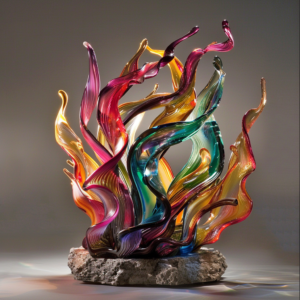The fiery allure of molten glass and the mesmerizing dance of the blowpipe have captivated artists for centuries. If you’ve ever dreamt of transforming molten glass into your own artistic creations, then glass sculpting might be the perfect art form for you. This guide will equip you with the essential steps to embark on your journey as a glass sculptor.
Step 1: Ignite Your Inspiration
Before diving into the technical aspects, immerse yourself in the world of glass sculpting. Visit museums and galleries to witness the breathtaking creations of renowned glass artists. Explore different glass sculpting techniques like lampworking, fusing, and casting. Browse online resources, attend exhibitions, and ignite your artistic passion by familiarizing yourself with the diverse styles and possibilities within this art form.
Step 2: Find Your Learning Path
There are two primary ways to begin your glass sculpting journey:
- Formal Glassblowing Classes: Enrolling in a beginner glassblowing class from a qualified instructor is highly recommended. These classes provide hands-on experience under the watchful eye of an expert. You’ll learn essential safety protocols, proper tool handling techniques, and fundamental shaping methods for creating basic glass sculptures.
- Glassblowing Studios with Open Studio Access: Some glassblowing studios offer open studio access for experienced artists. While not ideal for absolute beginners, this option can be suitable for those who have already taken introductory classes and want to practice their skills independently. Always ensure the studio offers proper safety equipment and has staff available to answer questions in case of need.
Step 3: Gather Your Essential Tools (For Class or Independent Practice)
If you opt for independent practice after taking introductory classes, here are some basic tools to get you started:
- Safety Gear: This is paramount. Invest in a good quality respirator, heat-resistant gloves, and safety glasses with strong, shatterproof lenses and side shields.
- Glassblowing Tools (if studio doesn’t provide): Basic tools might include a blowpipe, puntys (rods for holding glass), jacks (tweezers for manipulating glass), and marver (flat slab for smoothing glass).
- Glass Starter Kit: Many glass suppliers offer starter kits containing essential glassblowing tools and a small amount of glass (called “frit”) in various colors for practicing basic techniques.
Step 4: Master the Fundamentals
Whether in a class or independent practice session, focus on mastering the foundational skills of glassblowing:
- Gathering Glass: Learn how to safely gather molten glass from the furnace using the blowpipe.
- Shaping Techniques: Practice essential shaping techniques like blowing, marvering (rolling glass on a flat surface), and using tools to create indentations and manipulate the form.
- Annealing: Once your sculpture is formed, it’s crucial to cool it slowly in a kiln (annealing kiln) to prevent cracking from thermal stress.
Step 5: Experiment and Explore
As you gain confidence, begin to experiment with different techniques. Explore basic lampworking methods for adding color accents or creating detailed features. Consider incorporating glass fusing techniques to create layered glass pieces.
Step 6: Embrace the Imperfections
Remember, glass sculpting is a journey of exploration and experimentation. Embrace the inherent imperfections that arise during the process. These slight wobbles or unexpected color variations can add unique character to your creations.
Step 7: Find Your Artistic Voice
As you develop your skills, don’t be afraid to experiment and find your own artistic style. What stories do you want to tell through your glass sculptures? What shapes, colors, and techniques resonate most with you? Let your artistic vision guide you and allow your unique voice to emerge within the world of glass sculpting.
Step 8: Connect with the Glassblowing Community
The journey of a glass sculptor is not a solitary one. Connect with other glass artists, share your work, and learn from their experiences. Participating in workshops, joining online forums, or attending artist talks can provide valuable feedback and inspiration.
Conclusion: A Lifelong Journey of Artistic Exploration
Glass sculpting is a captivating art form that offers endless opportunities for creative expression. By following these steps, you’ll be well on your way to transforming molten glass into your artistic vision. Remember, the journey is just as important as the destination. Embrace the learning process, experiment with enthusiasm, and let your artistic spirit ignite within the fiery glow of the glass studio.



